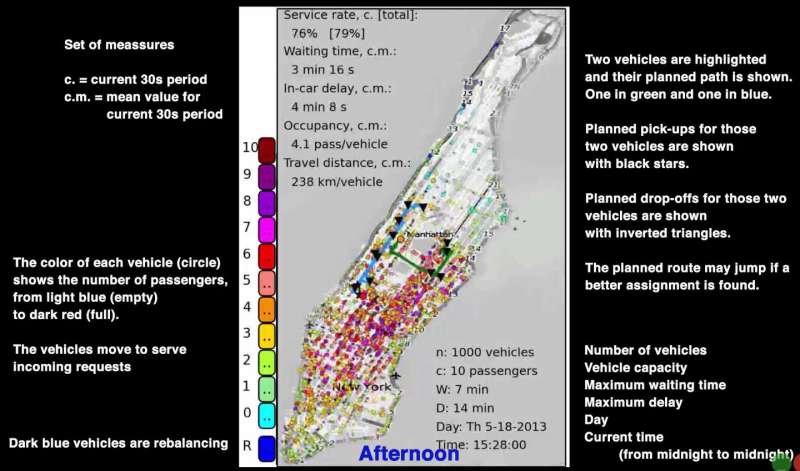January 3, 2017 report
Mathematical model shows ride sharing could dramatically reduce taxi numbers in Manhattan

(Tech Xplore)—A team of researchers at MIT has used mathematically modeling to create a computer system that is able to simulate car ride sharing in Manhattan under different scenarios. In their paper published in Proceedings of the National Academy of Sciences, the team describes their math, model and simulations and what they found when looking at the results.
Common sense suggests that if people were agreeable to sharing a metered ride, cities like New York could dramatically reduce the number of vehicles needed to ferry them around. In this new effort, the team at MIT created a model capable of showing how many vehicles would be needed to provide the same level of service as they receive today, if algorithms were used to make travel as efficient as possible—and if people were willing to share their ride.
To gain a better perspective on ways traffic could be better managed in large cities in the future taking into consideration the rise of services such as Uber, the researchers obtained data covering three million real taxi rides in Manhattan and then applied it to algorithms designed to improve efficiency—such as rerouting idle cabs to areas more in need—to see what sorts of improvements could be made. In looking at the model, the researchers found that in theory at least, it should be possible to reduce Manhattan's 14,000 taxis to just 3,000 four-passenger vehicles or 2,000 ten-passenger vehicles to provide nearly the same level of service as exists today—they suggest doing so would also reduce wait times and trip delays. Such a reduction, the researchers suggest, would mean less greenhouse gas emission, less work for the same amount of money for drivers and a better commute experience for riders due to fewer cars competing for the same road space.
There are some caveats, of course, the main one being that it is not clear how many riders would be willing to share their ride with someone else. In the real world, there are also other factors at play as well, such as drivers taking a different route than expected or taking breaks when they feel like it, or riders taking more time to board or to pay for their ride and disembark.
More information: "On-demand high-capacity ride-sharing via dynamic trip-vehicle assignment," PNAS, www.pnas.org/cgi/doi/10.1073/pnas.1611675114
© 2017 Tech Xplore


















